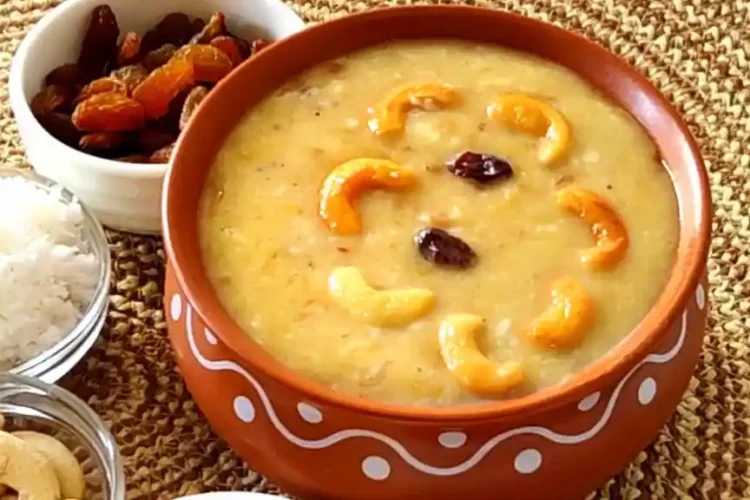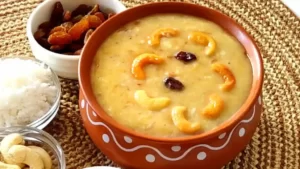Paal Payasam is a South Indian version of the traditional rice payasam made with milk, rice, and sugar. It is a rich and creamy dessert that is often served during special occasions and festivals.
It also known as Pal Payasam is a popular South Indian dessert that originated in the state of Kerala. “Paal” means milk in Malayalam, which is the main ingredient of this sweet dish. Its luscious taste and cultural significance has made it a cherished dessert in South Indian cuisine.
Paal Payasam can be served warm or chilled, depending on personal preference. It is enjoyed as a standalone dessert or as a sweet ending to a festive meal. The rich, creamy texture and aromatic flavors make paal payasam a beloved dessert among people of all ages.
The dish is often garnished with fried cashews, raisins, and sometimes edible rose petals, which add a delightful crunch and visual appeal. Overall, Paal payasam is a comforting and indulgent dessert that showcases the beauty of simplicity and the richness of milk.
Ingredients:
- 1/2 cup basmati rice
- 1-liter full-fat milk
- 1 cup sugar (adjust according to taste)
- 4-5 green cardamom pods, crushed
- A pinch of saffron strands
- 2 tablespoons ghee (clarified butter)
- A handful of cashews and raisins
- A few strands of edible rose petals for garnish (optional)
Instructions:
- Wash the rice thoroughly and soak it in water for 30 minutes. Drain the water and set aside.
- In a heavy-bottomed pan, heat the ghee over medium heat. Add the cashews and raisins and fry until the cashews turn golden brown and the raisins plump up. Remove them from the pan and set aside.
- In the same pan, add the drained rice and sauté for a couple of minutes until the grains are coated with ghee.
- Add the milk to the pan with rice. Bring it to a boil over medium heat, stirring occasionally to prevent sticking.
- Once the milk comes to a boil, reduce the heat to low and let the rice cook in the milk. Stir occasionally to prevent the rice from sticking to the bottom of the pan.
- Cook the rice in milk until it becomes soft and the milk reduces to a creamy consistency. This process can take around 1 to 1.5 hours. Be patient and stir occasionally.
- Once the rice is cooked and the payasam reaches the desired thickness, add the sugar and crushed cardamom pods. Stir well to dissolve the sugar completely.
- Crush the saffron strands and soak them in 1-2 tablespoons of warm milk. Add this saffron milk to the payasam and stir well. It will give a nice aroma and color to the dessert.
- Remove the payasam from the heat and garnish with fried cashews, raisins, and edible rose petals.
- Serve the paal payasam warm or chilled, according to your preference.
Enjoy the rich and creamy goodness of paal payasam!
Tips and Variations
Tips:
- Use full-fat milk: Using full-fat milk will result in a creamier and richer payasam. Avoid using low-fat or skim milk for the best texture and taste.
- Slow-cook for flavor: Slow-cooking the rice in milk allows the flavors to meld together and gives the payasam a more delicious taste. Be patient and stir occasionally to prevent sticking.
- Soak the rice: Soaking the rice for about 30 minutes before cooking will help in achieving a softer and evenly cooked texture.
- Sweetness adjustment: Adjust the amount of sugar according to your preference. You can start with a lesser amount and gradually add more if needed.
- Flavor with cardamom: Crush fresh green cardamom pods for the best flavor. You can also add a pinch of powdered cardamom if you prefer a stronger aroma.
Variations:
1: Vermicelli: Instead of rice, you can use roasted vermicelli to make Vermicelli Payasam. Cook the vermicelli in milk until tender and follow the same steps as for rice payasam.
2: Jaggery: Replace sugar with jaggery for a unique and caramel-like flavor. Dissolve the jaggery in a little water, strain it to remove impurities, and add it to the cooked rice and milk mixture.
3: Coconut Milk: Add a twist to the traditional recipe by substituting a portion of milk with coconut milk. The coconut milk will add a subtle tropical flavor to the payasam.
4: Dry fruits and nuts: Experiment with different combinations of dry fruits and nuts. You can add almonds, pistachios, dates, or even grated coconut for added texture and flavor.
5 Saffron and Rose Water: For an extra touch of elegance, infuse the payasam with a few strands of saffron soaked in warm milk and a splash of rose water. These ingredients will add a delightful fragrance and color to the dessert.
Serving suggestions
1:Paal Payasam can be served warm right after cooking, or you can refrigerate it and serve it chilled. Both options have their own charm, so choose based on your preference and the occasion.
2: Portion the Paal Payasam into individual serving bowls or cups. This allows for easy serving and adds an elegant touch to the presentation.
3:Top the Paal Payasam with a generous amount of fried cashews, raisins, and chopped almonds or pistachios. These add a delightful crunch and visual appeal to the creamy dessert.
4:Sprinkle a few strands of edible rose petals on top of the Paal Payasam for a beautiful and fragrant garnish. It adds a touch of sophistication and enhances the visual appeal.
5:Before serving, drizzle a teaspoon of ghee (clarified butter) on top of each serving. This enhances the flavor and richness of the payasam.
6:Paal Payasam is often enjoyed on its own, but you can serve it alongside some traditional Indian snacks or sweets. Popular accompaniments include banana chips, papadums, or even a small piece of jaggery.
Nutrition
| Calories | 473kcal |
| Fat | 14g |
| Iron |
1mg
|
| Sodium |
196mg
|
| Carbohydrates | 77g |
| Protein | 10g |
| Vitamin A |
349IU
|
| Calcium |
255mg
|



